Comprehensive Report on Management Accounting: Systems and Methods
VerifiedAdded on 2021/02/20
|16
|4300
|23
Report
AI Summary
This report delves into the core concepts of management accounting, examining its role in planning, organizing, monitoring, and controlling financial activities within a business. It explores different types of management accounting systems, including cost accounting, inventory management, job costing, and production control systems, highlighting their requirements and benefits. The report also discusses various methods of management accounting reporting, such as cash reports, production reports, sales reports, and budget reports, and provides a critical evaluation of their importance. Furthermore, it outlines different techniques of management accounting systems, like marginal costing and absorption costing, and explores planning tools for budgetary control, including fixed budgets, cash budgets, and zero-based budgets. The report emphasizes how these systems and techniques enable effective financial management and strategic decision-making within organizations.
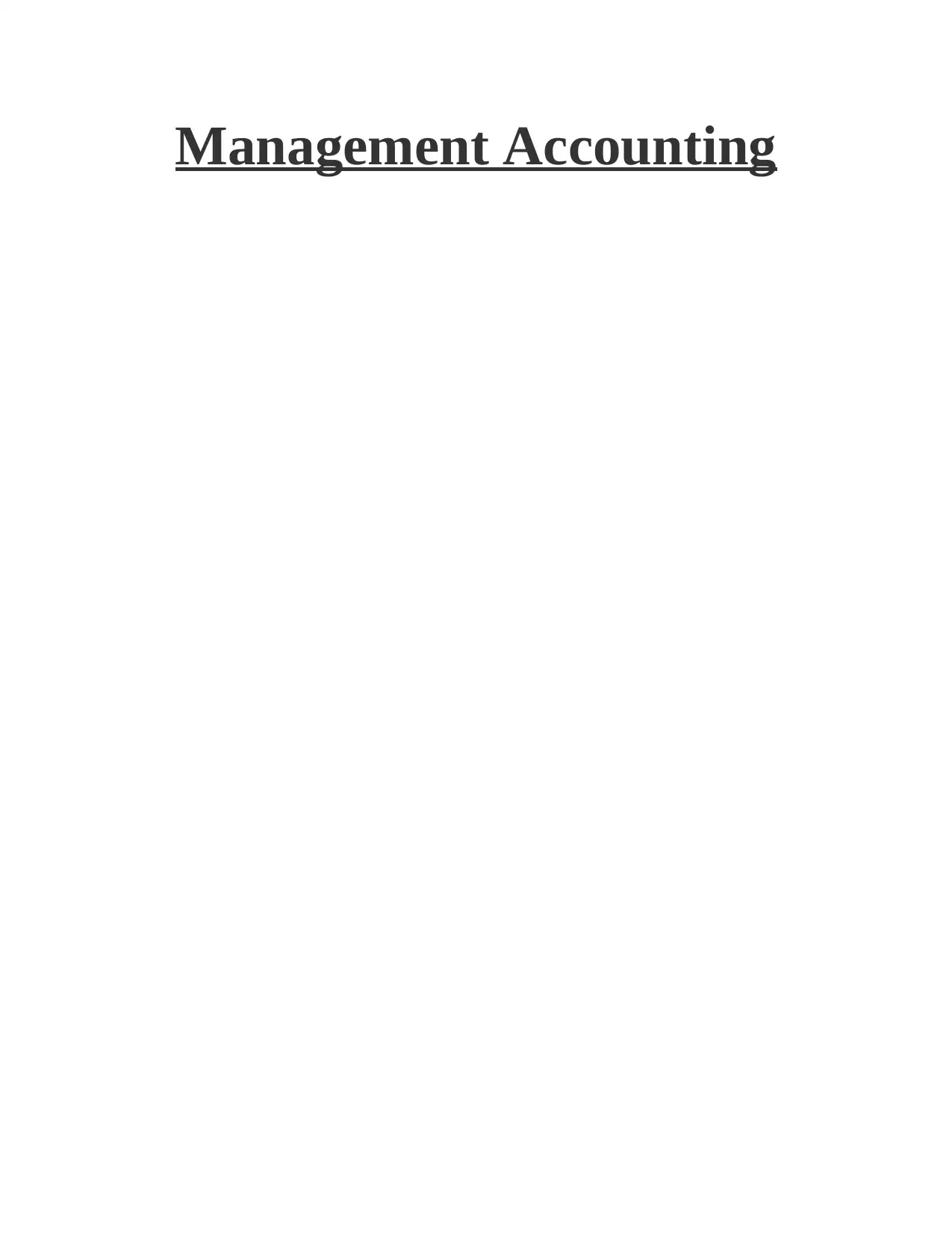
Management Accounting
Paraphrase This Document
Need a fresh take? Get an instant paraphrase of this document with our AI Paraphraser

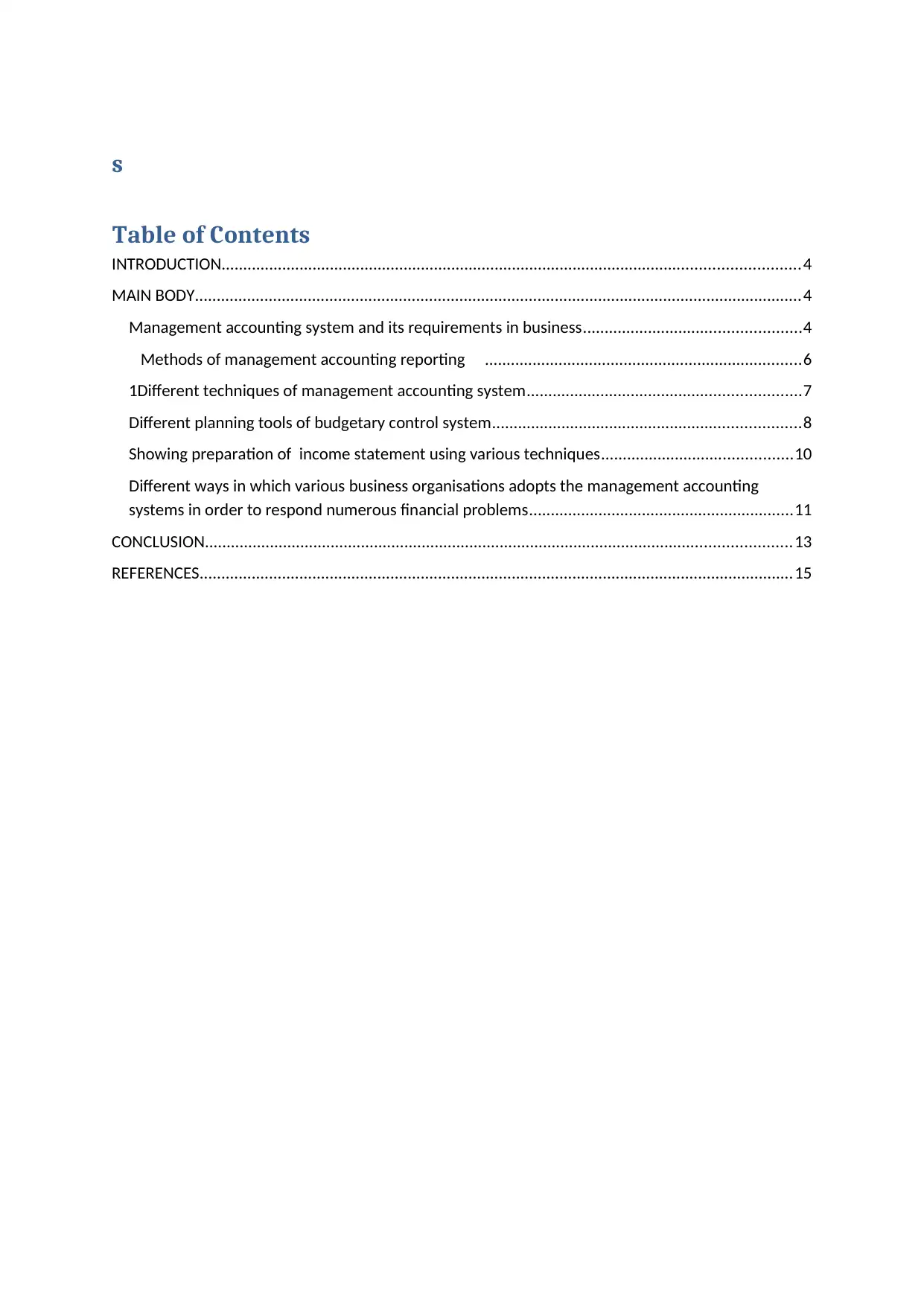
s
Table of Contents
INTRODUCTION.....................................................................................................................................4
MAIN BODY............................................................................................................................................4
Management accounting system and its requirements in business..................................................4
Methods of management accounting reporting .........................................................................6
1Different techniques of management accounting system...............................................................7
Different planning tools of budgetary control system.......................................................................8
Showing preparation of income statement using various techniques............................................10
Different ways in which various business organisations adopts the management accounting
systems in order to respond numerous financial problems.............................................................11
CONCLUSION.......................................................................................................................................13
REFERENCES.........................................................................................................................................15
Table of Contents
INTRODUCTION.....................................................................................................................................4
MAIN BODY............................................................................................................................................4
Management accounting system and its requirements in business..................................................4
Methods of management accounting reporting .........................................................................6
1Different techniques of management accounting system...............................................................7
Different planning tools of budgetary control system.......................................................................8
Showing preparation of income statement using various techniques............................................10
Different ways in which various business organisations adopts the management accounting
systems in order to respond numerous financial problems.............................................................11
CONCLUSION.......................................................................................................................................13
REFERENCES.........................................................................................................................................15
⊘ This is a preview!⊘
Do you want full access?
Subscribe today to unlock all pages.

Trusted by 1+ million students worldwide
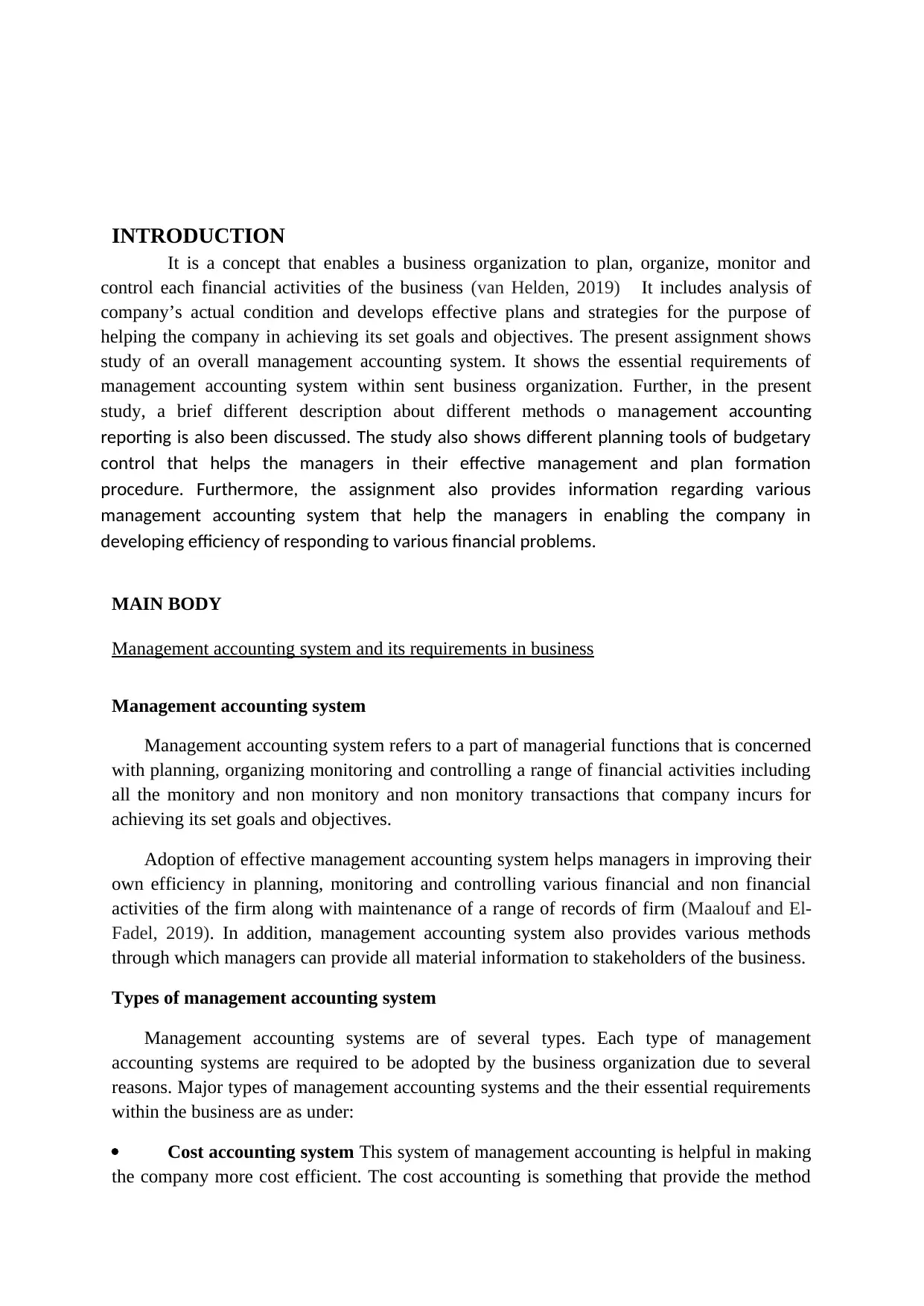
INTRODUCTION
It is a concept that enables a business organization to plan, organize, monitor and
control each financial activities of the business (van Helden, 2019) It includes analysis of
company’s actual condition and develops effective plans and strategies for the purpose of
helping the company in achieving its set goals and objectives. The present assignment shows
study of an overall management accounting system. It shows the essential requirements of
management accounting system within sent business organization. Further, in the present
study, a brief different description about different methods o management accounting
reporting is also been discussed. The study also shows different planning tools of budgetary
control that helps the managers in their effective management and plan formation
procedure. Furthermore, the assignment also provides information regarding various
management accounting system that help the managers in enabling the company in
developing efficiency of responding to various financial problems.
MAIN BODY
Management accounting system and its requirements in business
Management accounting system
Management accounting system refers to a part of managerial functions that is concerned
with planning, organizing monitoring and controlling a range of financial activities including
all the monitory and non monitory and non monitory transactions that company incurs for
achieving its set goals and objectives.
Adoption of effective management accounting system helps managers in improving their
own efficiency in planning, monitoring and controlling various financial and non financial
activities of the firm along with maintenance of a range of records of firm (Maalouf and El-
Fadel, 2019). In addition, management accounting system also provides various methods
through which managers can provide all material information to stakeholders of the business.
Types of management accounting system
Management accounting systems are of several types. Each type of management
accounting systems are required to be adopted by the business organization due to several
reasons. Major types of management accounting systems and the their essential requirements
within the business are as under:
Cost accounting system This system of management accounting is helpful in making
the company more cost efficient. The cost accounting is something that provide the method
It is a concept that enables a business organization to plan, organize, monitor and
control each financial activities of the business (van Helden, 2019) It includes analysis of
company’s actual condition and develops effective plans and strategies for the purpose of
helping the company in achieving its set goals and objectives. The present assignment shows
study of an overall management accounting system. It shows the essential requirements of
management accounting system within sent business organization. Further, in the present
study, a brief different description about different methods o management accounting
reporting is also been discussed. The study also shows different planning tools of budgetary
control that helps the managers in their effective management and plan formation
procedure. Furthermore, the assignment also provides information regarding various
management accounting system that help the managers in enabling the company in
developing efficiency of responding to various financial problems.
MAIN BODY
Management accounting system and its requirements in business
Management accounting system
Management accounting system refers to a part of managerial functions that is concerned
with planning, organizing monitoring and controlling a range of financial activities including
all the monitory and non monitory and non monitory transactions that company incurs for
achieving its set goals and objectives.
Adoption of effective management accounting system helps managers in improving their
own efficiency in planning, monitoring and controlling various financial and non financial
activities of the firm along with maintenance of a range of records of firm (Maalouf and El-
Fadel, 2019). In addition, management accounting system also provides various methods
through which managers can provide all material information to stakeholders of the business.
Types of management accounting system
Management accounting systems are of several types. Each type of management
accounting systems are required to be adopted by the business organization due to several
reasons. Major types of management accounting systems and the their essential requirements
within the business are as under:
Cost accounting system This system of management accounting is helpful in making
the company more cost efficient. The cost accounting is something that provide the method
Paraphrase This Document
Need a fresh take? Get an instant paraphrase of this document with our AI Paraphraser
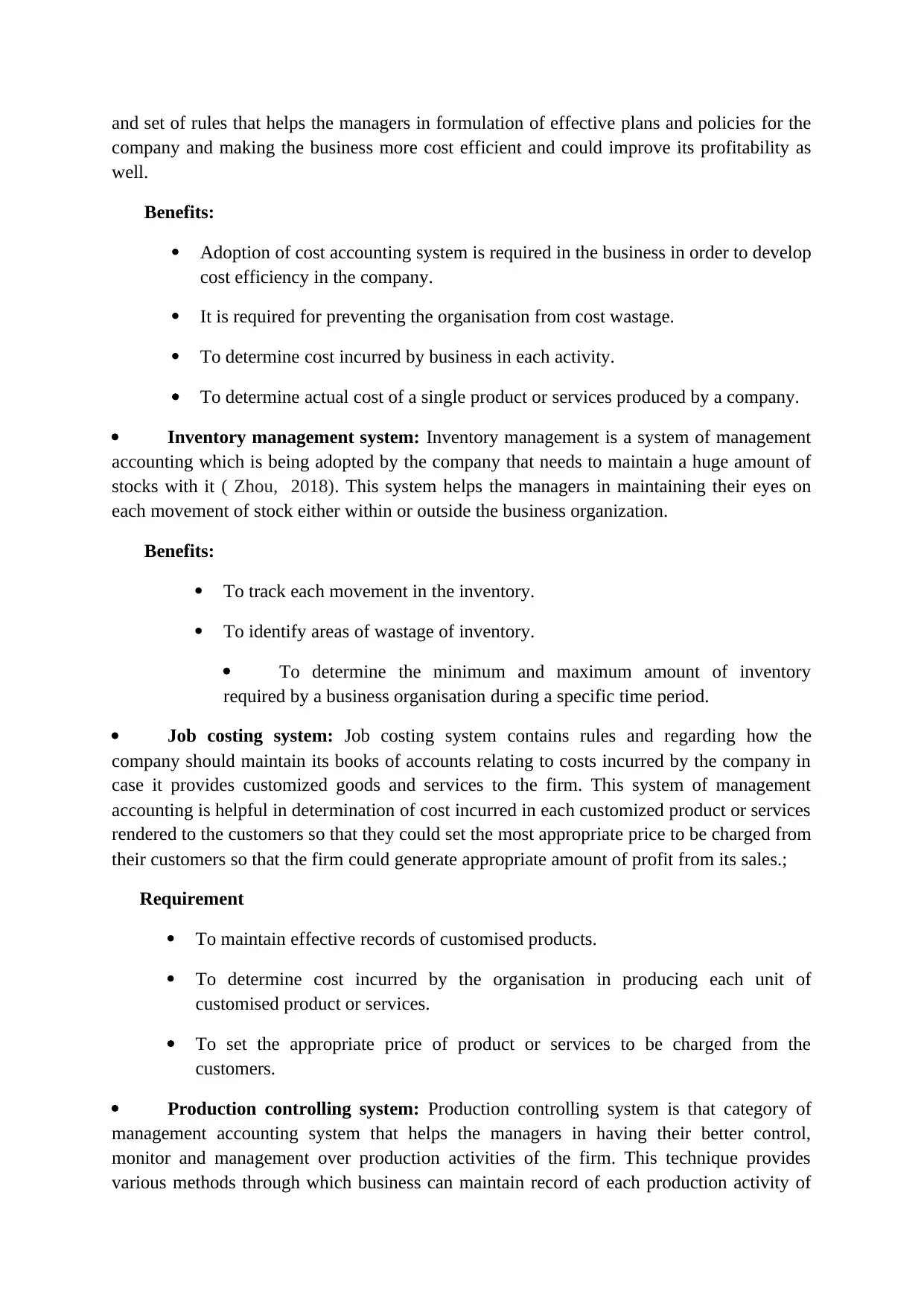
and set of rules that helps the managers in formulation of effective plans and policies for the
company and making the business more cost efficient and could improve its profitability as
well.
Benefits:
Adoption of cost accounting system is required in the business in order to develop
cost efficiency in the company.
It is required for preventing the organisation from cost wastage.
To determine cost incurred by business in each activity.
To determine actual cost of a single product or services produced by a company.
Inventory management system: Inventory management is a system of management
accounting which is being adopted by the company that needs to maintain a huge amount of
stocks with it ( Zhou, 2018). This system helps the managers in maintaining their eyes on
each movement of stock either within or outside the business organization.
Benefits:
To track each movement in the inventory.
To identify areas of wastage of inventory.
To determine the minimum and maximum amount of inventory
required by a business organisation during a specific time period.
Job costing system: Job costing system contains rules and regarding how the
company should maintain its books of accounts relating to costs incurred by the company in
case it provides customized goods and services to the firm. This system of management
accounting is helpful in determination of cost incurred in each customized product or services
rendered to the customers so that they could set the most appropriate price to be charged from
their customers so that the firm could generate appropriate amount of profit from its sales.;
Requirement
To maintain effective records of customised products.
To determine cost incurred by the organisation in producing each unit of
customised product or services.
To set the appropriate price of product or services to be charged from the
customers.
Production controlling system: Production controlling system is that category of
management accounting system that helps the managers in having their better control,
monitor and management over production activities of the firm. This technique provides
various methods through which business can maintain record of each production activity of
company and making the business more cost efficient and could improve its profitability as
well.
Benefits:
Adoption of cost accounting system is required in the business in order to develop
cost efficiency in the company.
It is required for preventing the organisation from cost wastage.
To determine cost incurred by business in each activity.
To determine actual cost of a single product or services produced by a company.
Inventory management system: Inventory management is a system of management
accounting which is being adopted by the company that needs to maintain a huge amount of
stocks with it ( Zhou, 2018). This system helps the managers in maintaining their eyes on
each movement of stock either within or outside the business organization.
Benefits:
To track each movement in the inventory.
To identify areas of wastage of inventory.
To determine the minimum and maximum amount of inventory
required by a business organisation during a specific time period.
Job costing system: Job costing system contains rules and regarding how the
company should maintain its books of accounts relating to costs incurred by the company in
case it provides customized goods and services to the firm. This system of management
accounting is helpful in determination of cost incurred in each customized product or services
rendered to the customers so that they could set the most appropriate price to be charged from
their customers so that the firm could generate appropriate amount of profit from its sales.;
Requirement
To maintain effective records of customised products.
To determine cost incurred by the organisation in producing each unit of
customised product or services.
To set the appropriate price of product or services to be charged from the
customers.
Production controlling system: Production controlling system is that category of
management accounting system that helps the managers in having their better control,
monitor and management over production activities of the firm. This technique provides
various methods through which business can maintain record of each production activity of
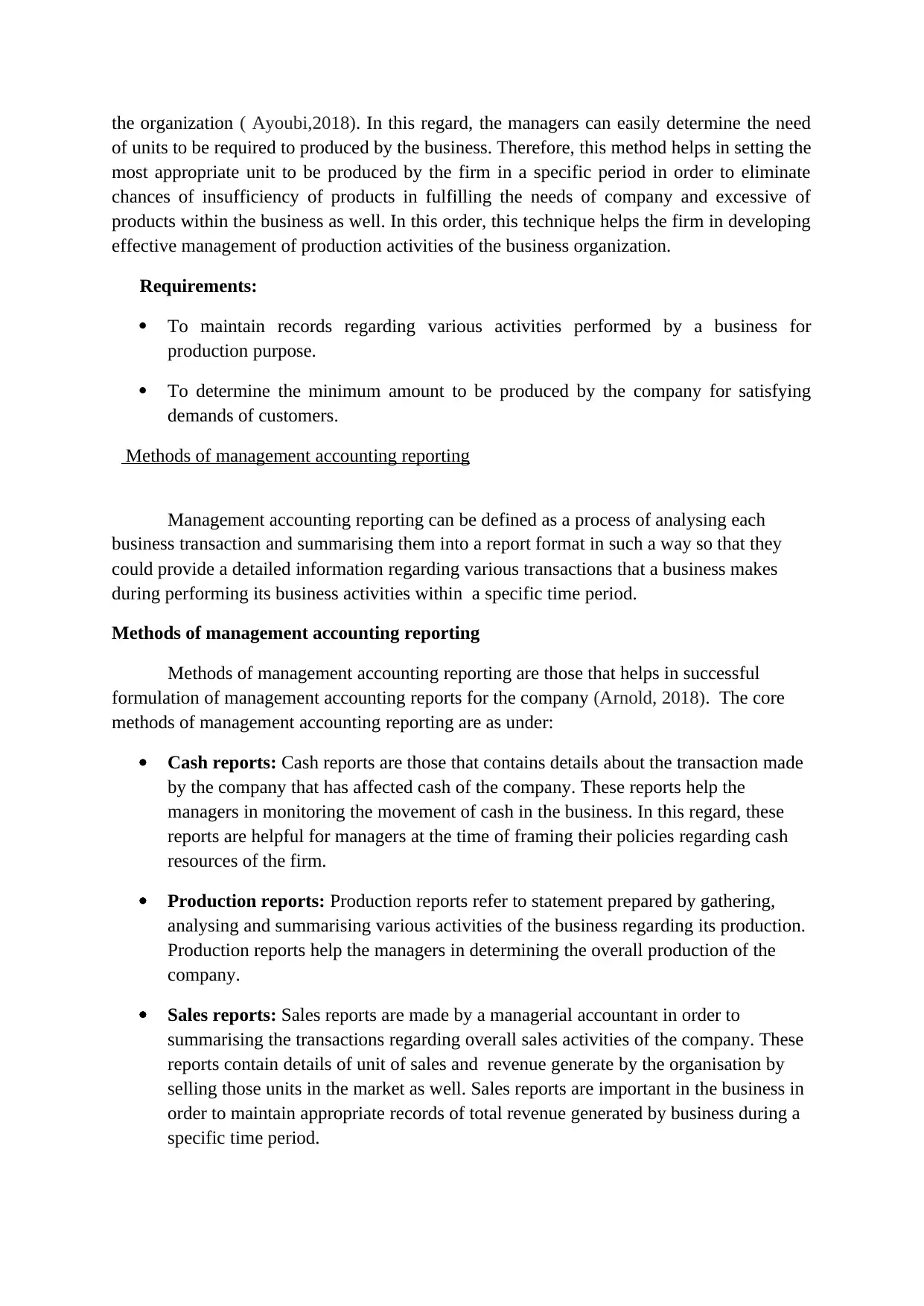
the organization ( Ayoubi,2018). In this regard, the managers can easily determine the need
of units to be required to produced by the business. Therefore, this method helps in setting the
most appropriate unit to be produced by the firm in a specific period in order to eliminate
chances of insufficiency of products in fulfilling the needs of company and excessive of
products within the business as well. In this order, this technique helps the firm in developing
effective management of production activities of the business organization.
Requirements:
To maintain records regarding various activities performed by a business for
production purpose.
To determine the minimum amount to be produced by the company for satisfying
demands of customers.
Methods of management accounting reporting
Management accounting reporting can be defined as a process of analysing each
business transaction and summarising them into a report format in such a way so that they
could provide a detailed information regarding various transactions that a business makes
during performing its business activities within a specific time period.
Methods of management accounting reporting
Methods of management accounting reporting are those that helps in successful
formulation of management accounting reports for the company (Arnold, 2018). The core
methods of management accounting reporting are as under:
Cash reports: Cash reports are those that contains details about the transaction made
by the company that has affected cash of the company. These reports help the
managers in monitoring the movement of cash in the business. In this regard, these
reports are helpful for managers at the time of framing their policies regarding cash
resources of the firm.
Production reports: Production reports refer to statement prepared by gathering,
analysing and summarising various activities of the business regarding its production.
Production reports help the managers in determining the overall production of the
company.
Sales reports: Sales reports are made by a managerial accountant in order to
summarising the transactions regarding overall sales activities of the company. These
reports contain details of unit of sales and revenue generate by the organisation by
selling those units in the market as well. Sales reports are important in the business in
order to maintain appropriate records of total revenue generated by business during a
specific time period.
of units to be required to produced by the business. Therefore, this method helps in setting the
most appropriate unit to be produced by the firm in a specific period in order to eliminate
chances of insufficiency of products in fulfilling the needs of company and excessive of
products within the business as well. In this order, this technique helps the firm in developing
effective management of production activities of the business organization.
Requirements:
To maintain records regarding various activities performed by a business for
production purpose.
To determine the minimum amount to be produced by the company for satisfying
demands of customers.
Methods of management accounting reporting
Management accounting reporting can be defined as a process of analysing each
business transaction and summarising them into a report format in such a way so that they
could provide a detailed information regarding various transactions that a business makes
during performing its business activities within a specific time period.
Methods of management accounting reporting
Methods of management accounting reporting are those that helps in successful
formulation of management accounting reports for the company (Arnold, 2018). The core
methods of management accounting reporting are as under:
Cash reports: Cash reports are those that contains details about the transaction made
by the company that has affected cash of the company. These reports help the
managers in monitoring the movement of cash in the business. In this regard, these
reports are helpful for managers at the time of framing their policies regarding cash
resources of the firm.
Production reports: Production reports refer to statement prepared by gathering,
analysing and summarising various activities of the business regarding its production.
Production reports help the managers in determining the overall production of the
company.
Sales reports: Sales reports are made by a managerial accountant in order to
summarising the transactions regarding overall sales activities of the company. These
reports contain details of unit of sales and revenue generate by the organisation by
selling those units in the market as well. Sales reports are important in the business in
order to maintain appropriate records of total revenue generated by business during a
specific time period.
⊘ This is a preview!⊘
Do you want full access?
Subscribe today to unlock all pages.

Trusted by 1+ million students worldwide
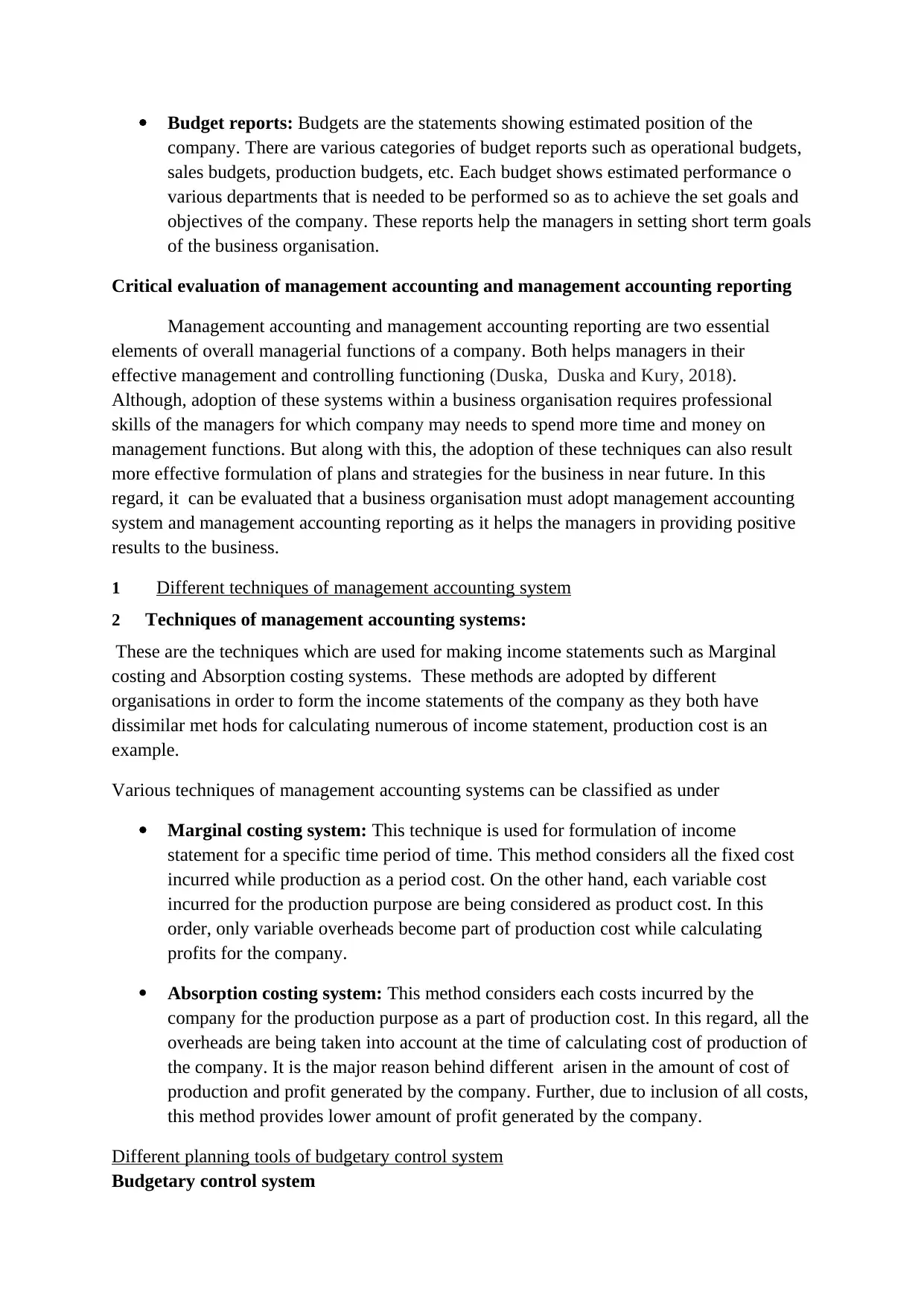
Budget reports: Budgets are the statements showing estimated position of the
company. There are various categories of budget reports such as operational budgets,
sales budgets, production budgets, etc. Each budget shows estimated performance o
various departments that is needed to be performed so as to achieve the set goals and
objectives of the company. These reports help the managers in setting short term goals
of the business organisation.
Critical evaluation of management accounting and management accounting reporting
Management accounting and management accounting reporting are two essential
elements of overall managerial functions of a company. Both helps managers in their
effective management and controlling functioning (Duska, Duska and Kury, 2018).
Although, adoption of these systems within a business organisation requires professional
skills of the managers for which company may needs to spend more time and money on
management functions. But along with this, the adoption of these techniques can also result
more effective formulation of plans and strategies for the business in near future. In this
regard, it can be evaluated that a business organisation must adopt management accounting
system and management accounting reporting as it helps the managers in providing positive
results to the business.
1 Different techniques of management accounting system
2 Techniques of management accounting systems:
These are the techniques which are used for making income statements such as Marginal
costing and Absorption costing systems. These methods are adopted by different
organisations in order to form the income statements of the company as they both have
dissimilar met hods for calculating numerous of income statement, production cost is an
example.
Various techniques of management accounting systems can be classified as under
Marginal costing system: This technique is used for formulation of income
statement for a specific time period of time. This method considers all the fixed cost
incurred while production as a period cost. On the other hand, each variable cost
incurred for the production purpose are being considered as product cost. In this
order, only variable overheads become part of production cost while calculating
profits for the company.
Absorption costing system: This method considers each costs incurred by the
company for the production purpose as a part of production cost. In this regard, all the
overheads are being taken into account at the time of calculating cost of production of
the company. It is the major reason behind different arisen in the amount of cost of
production and profit generated by the company. Further, due to inclusion of all costs,
this method provides lower amount of profit generated by the company.
Different planning tools of budgetary control system
Budgetary control system
company. There are various categories of budget reports such as operational budgets,
sales budgets, production budgets, etc. Each budget shows estimated performance o
various departments that is needed to be performed so as to achieve the set goals and
objectives of the company. These reports help the managers in setting short term goals
of the business organisation.
Critical evaluation of management accounting and management accounting reporting
Management accounting and management accounting reporting are two essential
elements of overall managerial functions of a company. Both helps managers in their
effective management and controlling functioning (Duska, Duska and Kury, 2018).
Although, adoption of these systems within a business organisation requires professional
skills of the managers for which company may needs to spend more time and money on
management functions. But along with this, the adoption of these techniques can also result
more effective formulation of plans and strategies for the business in near future. In this
regard, it can be evaluated that a business organisation must adopt management accounting
system and management accounting reporting as it helps the managers in providing positive
results to the business.
1 Different techniques of management accounting system
2 Techniques of management accounting systems:
These are the techniques which are used for making income statements such as Marginal
costing and Absorption costing systems. These methods are adopted by different
organisations in order to form the income statements of the company as they both have
dissimilar met hods for calculating numerous of income statement, production cost is an
example.
Various techniques of management accounting systems can be classified as under
Marginal costing system: This technique is used for formulation of income
statement for a specific time period of time. This method considers all the fixed cost
incurred while production as a period cost. On the other hand, each variable cost
incurred for the production purpose are being considered as product cost. In this
order, only variable overheads become part of production cost while calculating
profits for the company.
Absorption costing system: This method considers each costs incurred by the
company for the production purpose as a part of production cost. In this regard, all the
overheads are being taken into account at the time of calculating cost of production of
the company. It is the major reason behind different arisen in the amount of cost of
production and profit generated by the company. Further, due to inclusion of all costs,
this method provides lower amount of profit generated by the company.
Different planning tools of budgetary control system
Budgetary control system
Paraphrase This Document
Need a fresh take? Get an instant paraphrase of this document with our AI Paraphraser
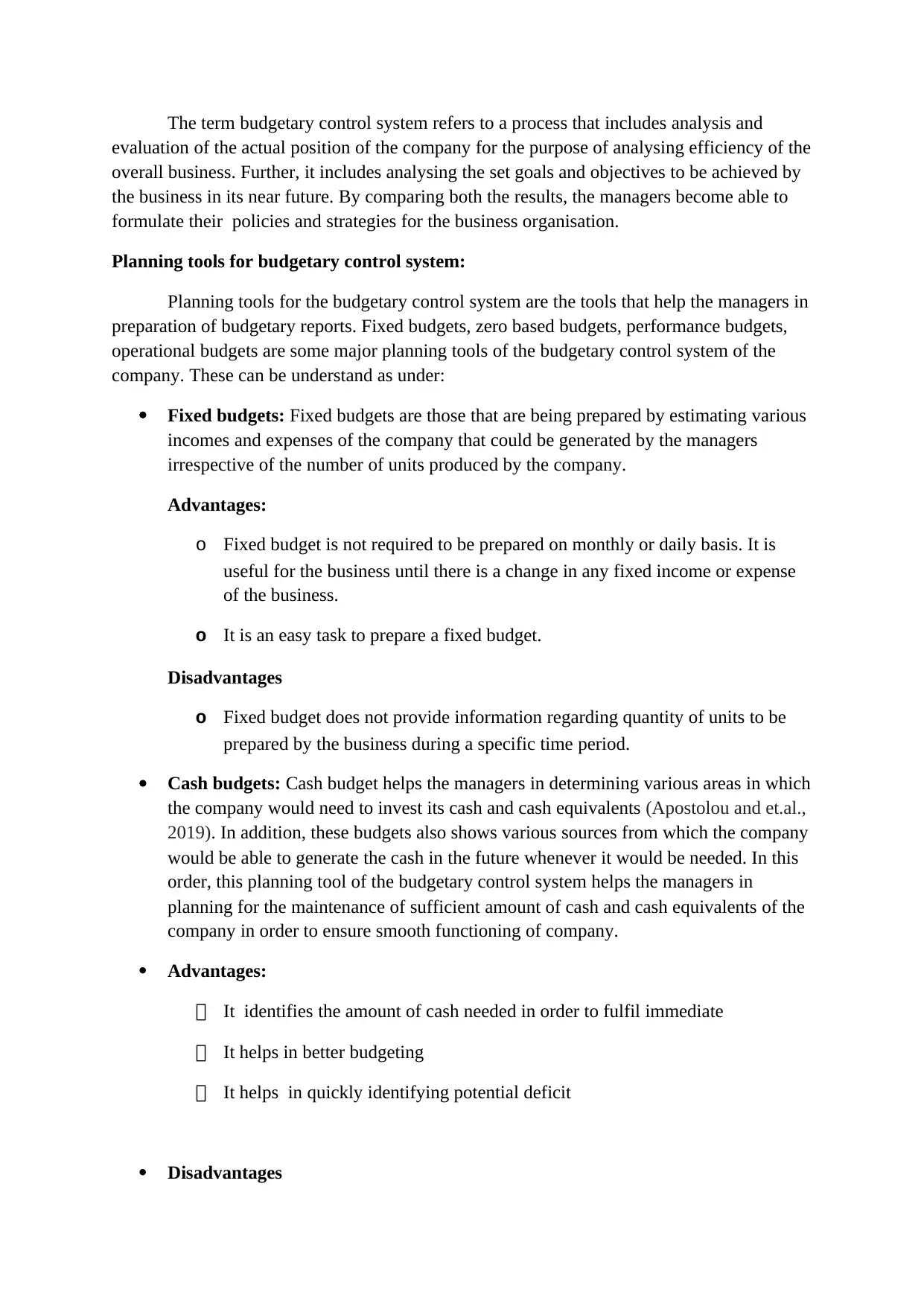
The term budgetary control system refers to a process that includes analysis and
evaluation of the actual position of the company for the purpose of analysing efficiency of the
overall business. Further, it includes analysing the set goals and objectives to be achieved by
the business in its near future. By comparing both the results, the managers become able to
formulate their policies and strategies for the business organisation.
Planning tools for budgetary control system:
Planning tools for the budgetary control system are the tools that help the managers in
preparation of budgetary reports. Fixed budgets, zero based budgets, performance budgets,
operational budgets are some major planning tools of the budgetary control system of the
company. These can be understand as under:
Fixed budgets: Fixed budgets are those that are being prepared by estimating various
incomes and expenses of the company that could be generated by the managers
irrespective of the number of units produced by the company.
Advantages:
o Fixed budget is not required to be prepared on monthly or daily basis. It is
useful for the business until there is a change in any fixed income or expense
of the business.
o It is an easy task to prepare a fixed budget.
Disadvantages
o Fixed budget does not provide information regarding quantity of units to be
prepared by the business during a specific time period.
Cash budgets: Cash budget helps the managers in determining various areas in which
the company would need to invest its cash and cash equivalents (Apostolou and et.al.,
2019). In addition, these budgets also shows various sources from which the company
would be able to generate the cash in the future whenever it would be needed. In this
order, this planning tool of the budgetary control system helps the managers in
planning for the maintenance of sufficient amount of cash and cash equivalents of the
company in order to ensure smooth functioning of company.
Advantages:
It identifies the amount of cash needed in order to fulfil immediate
It helps in better budgeting
It helps in quickly identifying potential deficit
Disadvantages
evaluation of the actual position of the company for the purpose of analysing efficiency of the
overall business. Further, it includes analysing the set goals and objectives to be achieved by
the business in its near future. By comparing both the results, the managers become able to
formulate their policies and strategies for the business organisation.
Planning tools for budgetary control system:
Planning tools for the budgetary control system are the tools that help the managers in
preparation of budgetary reports. Fixed budgets, zero based budgets, performance budgets,
operational budgets are some major planning tools of the budgetary control system of the
company. These can be understand as under:
Fixed budgets: Fixed budgets are those that are being prepared by estimating various
incomes and expenses of the company that could be generated by the managers
irrespective of the number of units produced by the company.
Advantages:
o Fixed budget is not required to be prepared on monthly or daily basis. It is
useful for the business until there is a change in any fixed income or expense
of the business.
o It is an easy task to prepare a fixed budget.
Disadvantages
o Fixed budget does not provide information regarding quantity of units to be
prepared by the business during a specific time period.
Cash budgets: Cash budget helps the managers in determining various areas in which
the company would need to invest its cash and cash equivalents (Apostolou and et.al.,
2019). In addition, these budgets also shows various sources from which the company
would be able to generate the cash in the future whenever it would be needed. In this
order, this planning tool of the budgetary control system helps the managers in
planning for the maintenance of sufficient amount of cash and cash equivalents of the
company in order to ensure smooth functioning of company.
Advantages:
It identifies the amount of cash needed in order to fulfil immediate
It helps in better budgeting
It helps in quickly identifying potential deficit
Disadvantages
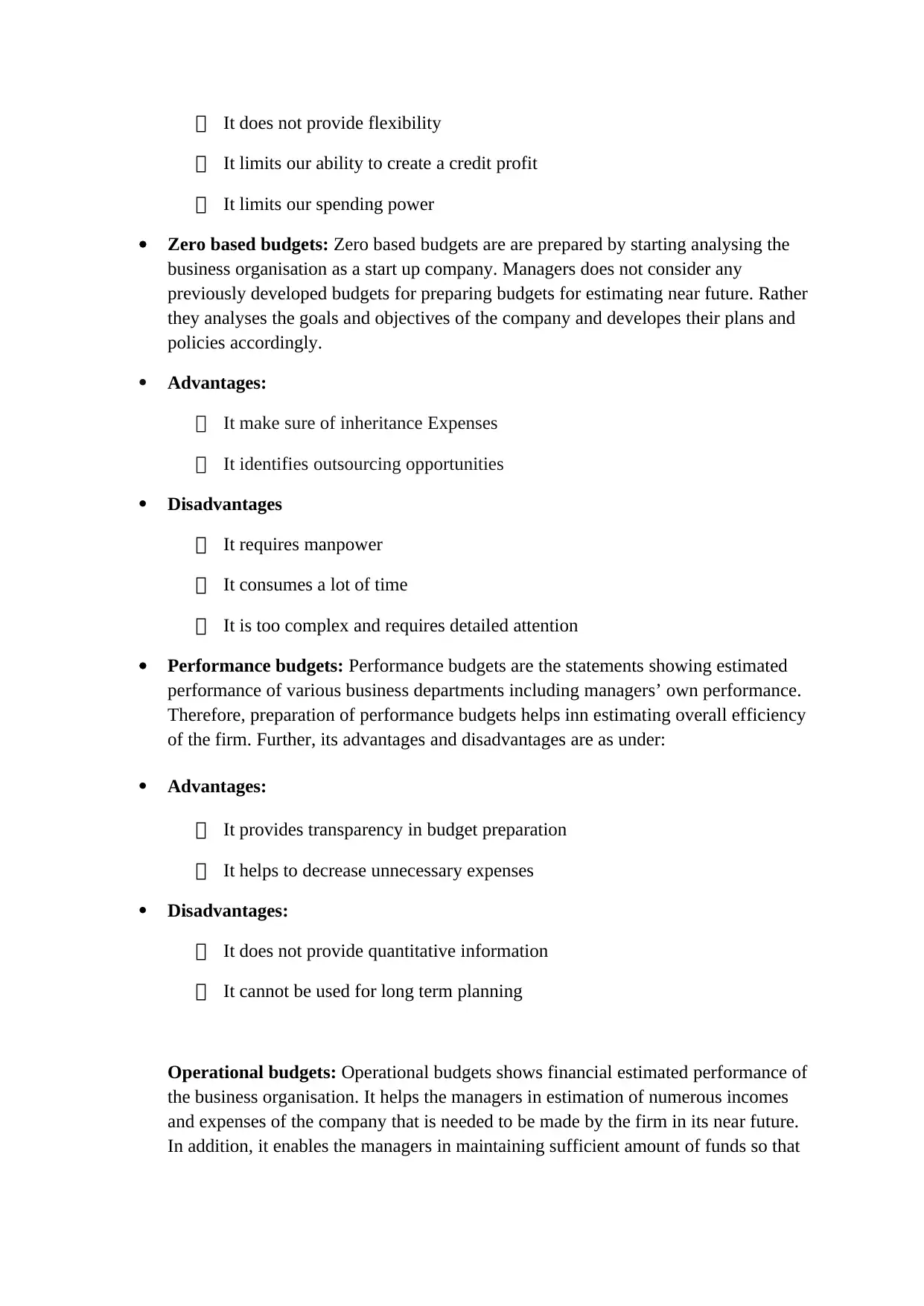
It does not provide flexibility
It limits our ability to create a credit profit
It limits our spending power
Zero based budgets: Zero based budgets are are prepared by starting analysing the
business organisation as a start up company. Managers does not consider any
previously developed budgets for preparing budgets for estimating near future. Rather
they analyses the goals and objectives of the company and developes their plans and
policies accordingly.
Advantages:
It make sure of inheritance Expenses
It identifies outsourcing opportunities
Disadvantages
It requires manpower
It consumes a lot of time
It is too complex and requires detailed attention
Performance budgets: Performance budgets are the statements showing estimated
performance of various business departments including managers’ own performance.
Therefore, preparation of performance budgets helps inn estimating overall efficiency
of the firm. Further, its advantages and disadvantages are as under:
Advantages:
It provides transparency in budget preparation
It helps to decrease unnecessary expenses
Disadvantages:
It does not provide quantitative information
It cannot be used for long term planning
Operational budgets: Operational budgets shows financial estimated performance of
the business organisation. It helps the managers in estimation of numerous incomes
and expenses of the company that is needed to be made by the firm in its near future.
In addition, it enables the managers in maintaining sufficient amount of funds so that
It limits our ability to create a credit profit
It limits our spending power
Zero based budgets: Zero based budgets are are prepared by starting analysing the
business organisation as a start up company. Managers does not consider any
previously developed budgets for preparing budgets for estimating near future. Rather
they analyses the goals and objectives of the company and developes their plans and
policies accordingly.
Advantages:
It make sure of inheritance Expenses
It identifies outsourcing opportunities
Disadvantages
It requires manpower
It consumes a lot of time
It is too complex and requires detailed attention
Performance budgets: Performance budgets are the statements showing estimated
performance of various business departments including managers’ own performance.
Therefore, preparation of performance budgets helps inn estimating overall efficiency
of the firm. Further, its advantages and disadvantages are as under:
Advantages:
It provides transparency in budget preparation
It helps to decrease unnecessary expenses
Disadvantages:
It does not provide quantitative information
It cannot be used for long term planning
Operational budgets: Operational budgets shows financial estimated performance of
the business organisation. It helps the managers in estimation of numerous incomes
and expenses of the company that is needed to be made by the firm in its near future.
In addition, it enables the managers in maintaining sufficient amount of funds so that
⊘ This is a preview!⊘
Do you want full access?
Subscribe today to unlock all pages.

Trusted by 1+ million students worldwide
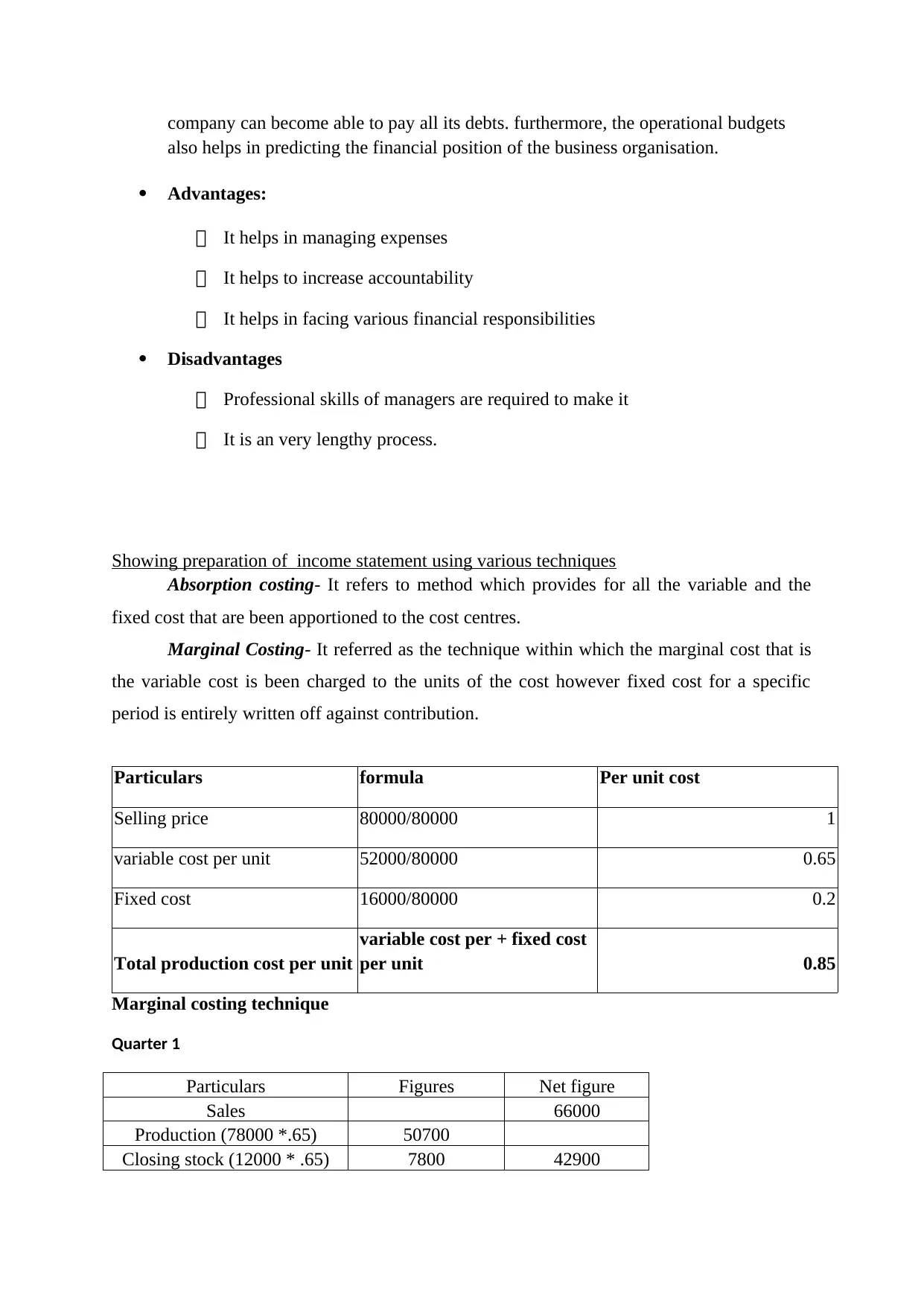
company can become able to pay all its debts. furthermore, the operational budgets
also helps in predicting the financial position of the business organisation.
Advantages:
It helps in managing expenses
It helps to increase accountability
It helps in facing various financial responsibilities
Disadvantages
Professional skills of managers are required to make it
It is an very lengthy process.
Showing preparation of income statement using various techniques
Absorption costing- It refers to method which provides for all the variable and the
fixed cost that are been apportioned to the cost centres.
Marginal Costing- It referred as the technique within which the marginal cost that is
the variable cost is been charged to the units of the cost however fixed cost for a specific
period is entirely written off against contribution.
Particulars formula Per unit cost
Selling price 80000/80000 1
variable cost per unit 52000/80000 0.65
Fixed cost 16000/80000 0.2
Total production cost per unit
variable cost per + fixed cost
per unit 0.85
Marginal costing technique
Quarter 1
Particulars Figures Net figure
Sales 66000
Production (78000 *.65) 50700
Closing stock (12000 * .65) 7800 42900
also helps in predicting the financial position of the business organisation.
Advantages:
It helps in managing expenses
It helps to increase accountability
It helps in facing various financial responsibilities
Disadvantages
Professional skills of managers are required to make it
It is an very lengthy process.
Showing preparation of income statement using various techniques
Absorption costing- It refers to method which provides for all the variable and the
fixed cost that are been apportioned to the cost centres.
Marginal Costing- It referred as the technique within which the marginal cost that is
the variable cost is been charged to the units of the cost however fixed cost for a specific
period is entirely written off against contribution.
Particulars formula Per unit cost
Selling price 80000/80000 1
variable cost per unit 52000/80000 0.65
Fixed cost 16000/80000 0.2
Total production cost per unit
variable cost per + fixed cost
per unit 0.85
Marginal costing technique
Quarter 1
Particulars Figures Net figure
Sales 66000
Production (78000 *.65) 50700
Closing stock (12000 * .65) 7800 42900
Paraphrase This Document
Need a fresh take? Get an instant paraphrase of this document with our AI Paraphraser
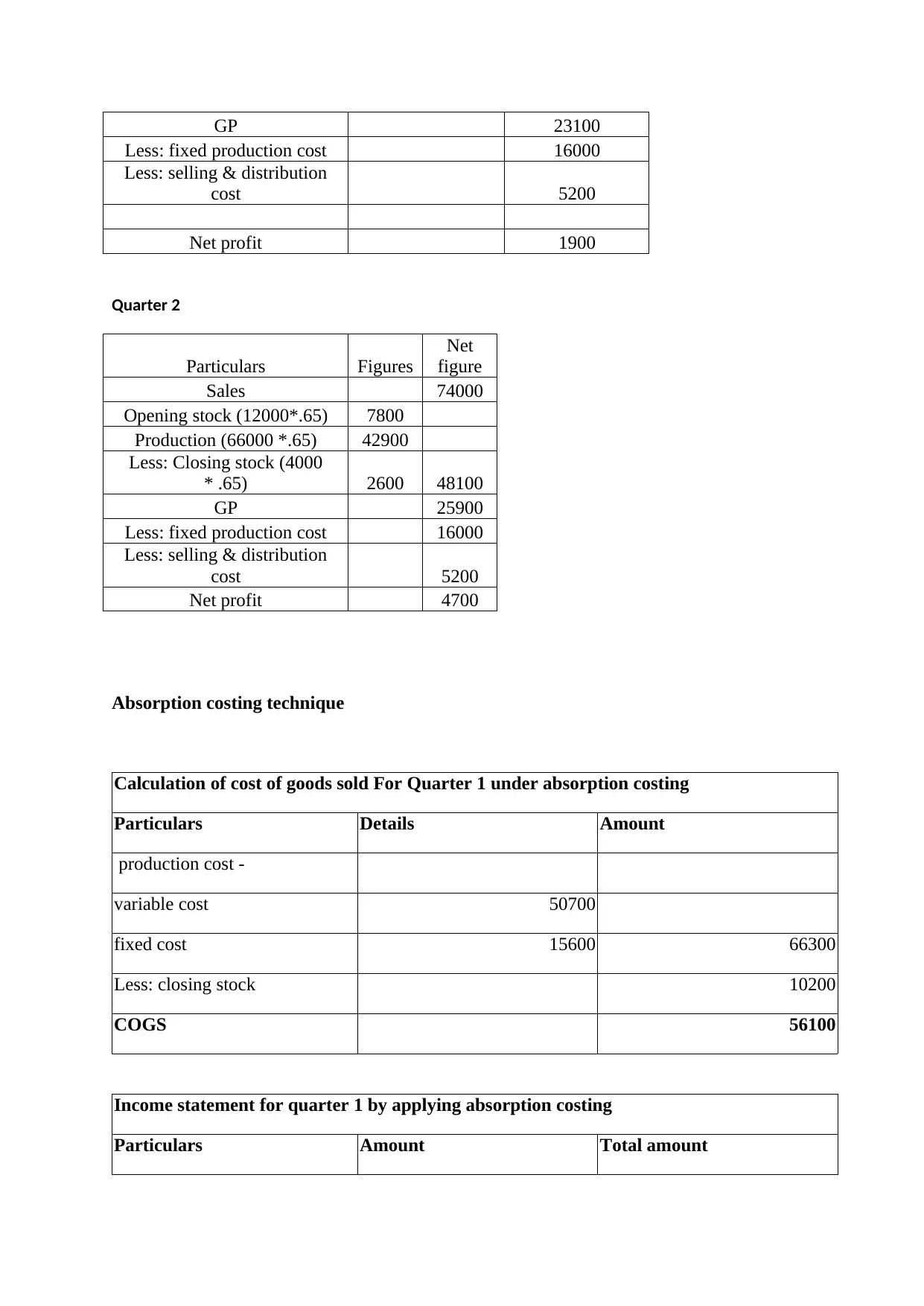
GP 23100
Less: fixed production cost 16000
Less: selling & distribution
cost 5200
Net profit 1900
Quarter 2
Particulars Figures
Net
figure
Sales 74000
Opening stock (12000*.65) 7800
Production (66000 *.65) 42900
Less: Closing stock (4000
* .65) 2600 48100
GP 25900
Less: fixed production cost 16000
Less: selling & distribution
cost 5200
Net profit 4700
Absorption costing technique
Calculation of cost of goods sold For Quarter 1 under absorption costing
Particulars Details Amount
production cost -
variable cost 50700
fixed cost 15600 66300
Less: closing stock 10200
COGS 56100
Income statement for quarter 1 by applying absorption costing
Particulars Amount Total amount
Less: fixed production cost 16000
Less: selling & distribution
cost 5200
Net profit 1900
Quarter 2
Particulars Figures
Net
figure
Sales 74000
Opening stock (12000*.65) 7800
Production (66000 *.65) 42900
Less: Closing stock (4000
* .65) 2600 48100
GP 25900
Less: fixed production cost 16000
Less: selling & distribution
cost 5200
Net profit 4700
Absorption costing technique
Calculation of cost of goods sold For Quarter 1 under absorption costing
Particulars Details Amount
production cost -
variable cost 50700
fixed cost 15600 66300
Less: closing stock 10200
COGS 56100
Income statement for quarter 1 by applying absorption costing
Particulars Amount Total amount
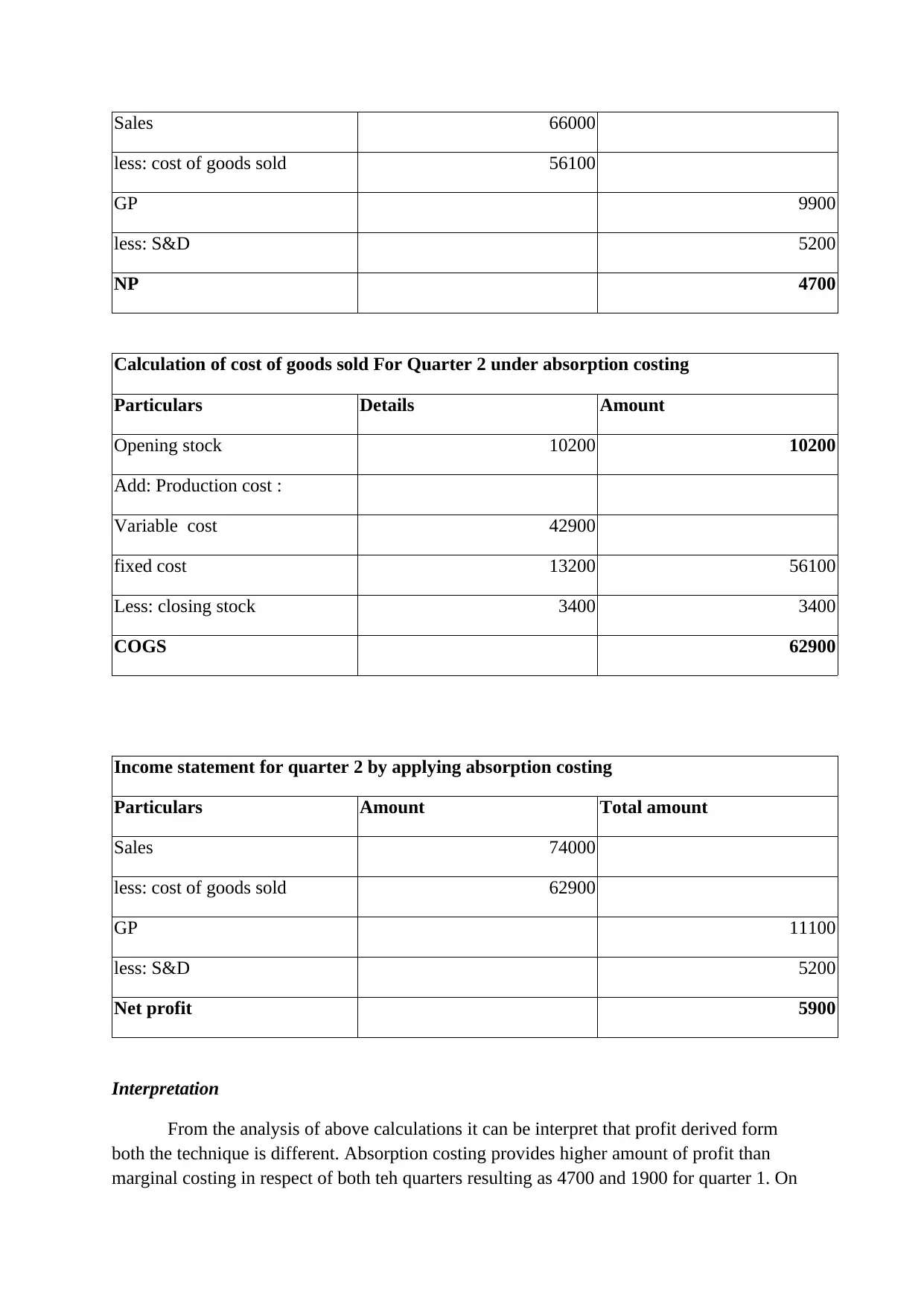
Sales 66000
less: cost of goods sold 56100
GP 9900
less: S&D 5200
NP 4700
Calculation of cost of goods sold For Quarter 2 under absorption costing
Particulars Details Amount
Opening stock 10200 10200
Add: Production cost :
Variable cost 42900
fixed cost 13200 56100
Less: closing stock 3400 3400
COGS 62900
Income statement for quarter 2 by applying absorption costing
Particulars Amount Total amount
Sales 74000
less: cost of goods sold 62900
GP 11100
less: S&D 5200
Net profit 5900
Interpretation
From the analysis of above calculations it can be interpret that profit derived form
both the technique is different. Absorption costing provides higher amount of profit than
marginal costing in respect of both teh quarters resulting as 4700 and 1900 for quarter 1. On
less: cost of goods sold 56100
GP 9900
less: S&D 5200
NP 4700
Calculation of cost of goods sold For Quarter 2 under absorption costing
Particulars Details Amount
Opening stock 10200 10200
Add: Production cost :
Variable cost 42900
fixed cost 13200 56100
Less: closing stock 3400 3400
COGS 62900
Income statement for quarter 2 by applying absorption costing
Particulars Amount Total amount
Sales 74000
less: cost of goods sold 62900
GP 11100
less: S&D 5200
Net profit 5900
Interpretation
From the analysis of above calculations it can be interpret that profit derived form
both the technique is different. Absorption costing provides higher amount of profit than
marginal costing in respect of both teh quarters resulting as 4700 and 1900 for quarter 1. On
⊘ This is a preview!⊘
Do you want full access?
Subscribe today to unlock all pages.

Trusted by 1+ million students worldwide
1 out of 16
Related Documents
Your All-in-One AI-Powered Toolkit for Academic Success.
+13062052269
info@desklib.com
Available 24*7 on WhatsApp / Email
![[object Object]](/_next/static/media/star-bottom.7253800d.svg)
Unlock your academic potential
Copyright © 2020–2025 A2Z Services. All Rights Reserved. Developed and managed by ZUCOL.





